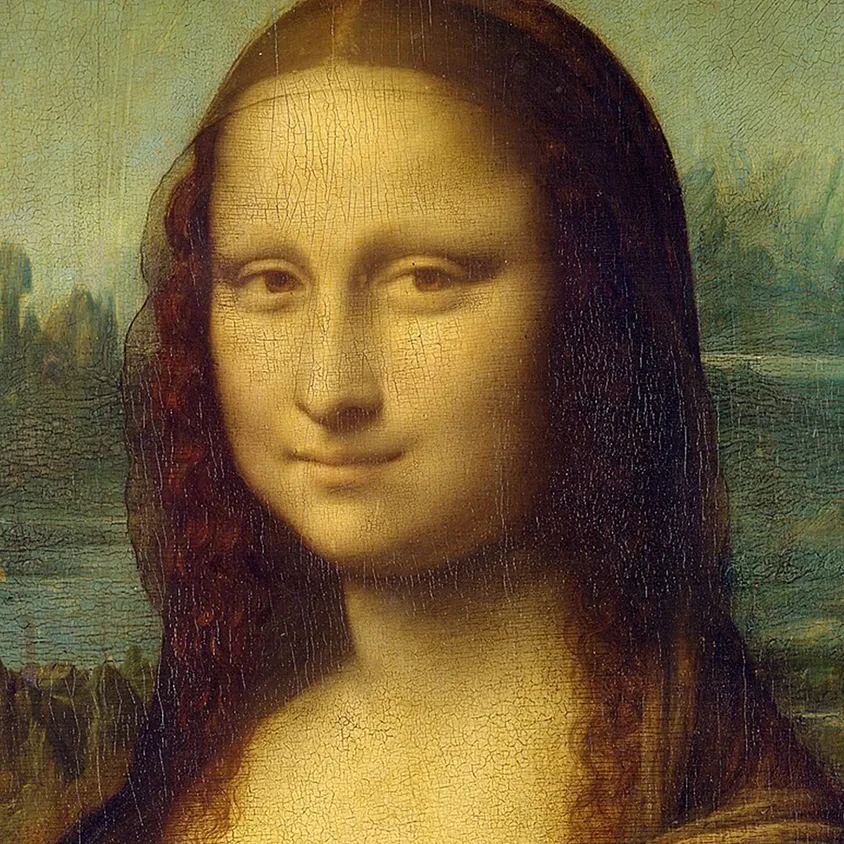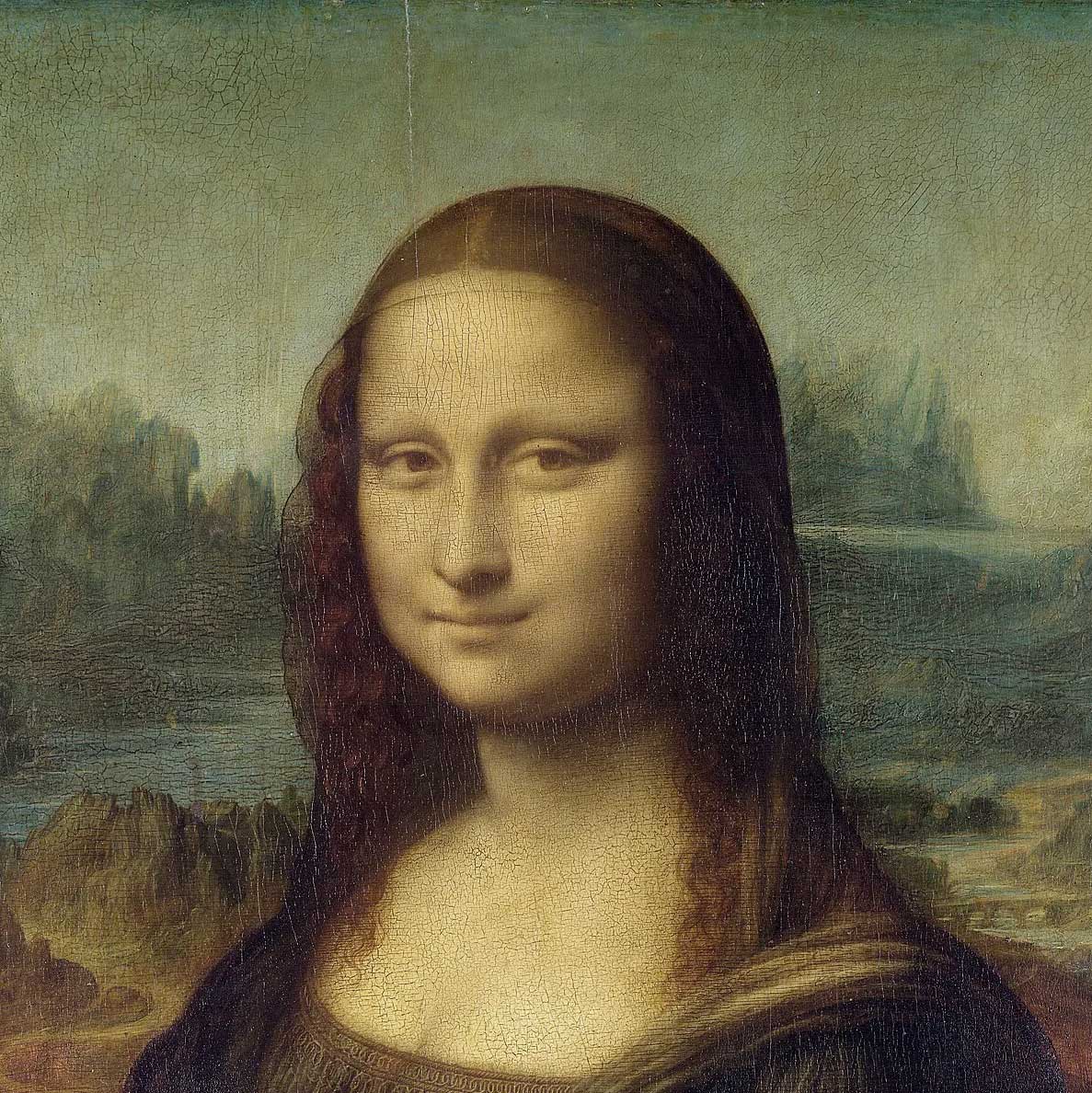Overview of the Mona Lisa
The Mona Lisa, painted by Leonardo da Vinci between 1503 and 1519, is undoubtedly one of the most renowned artworks in the world.This masterpiece is an iconic representation of the Renaissance art movement and has captivated audiences for centuries with its enigmatic expression and cultural significance. The painting depicts a woman, believed to be Lisa del Giocondo, the wife of a Florentine merchant, in a frontal face position with turned shoulders and included hands.
The Mona Lisa’s fame can be attributed to various factors. First and foremost, it is a work by Leonardo da Vinci, one of the greatest artists in history. Leonardo’s attention to detail, his innovative techniques, and his ability to capture the human form with remarkable accuracy make the Mona Lisa a true masterpiece. Additionally, the Mona Lisa’s enigmatic smile has intrigued viewers for centuries, sparking countless debates and interpretations. The painting’s mysterious quality has contributed to its enduring popularity and cultural significance.
History of the Mona Lisa
Leonardo da Vinci never delivered the Mona Lisa to its original patron and instead kept it with him when he went to work for Francis I, the King of France.After Leonardo’s death, the painting came into the possession of the French monarchy and was displayed in various locations, including the palaces of Francois I, Louis XIV, and Napoleon. Over time, it gained popularity and became an icon of Renaissance art, captivating the imaginations of artists and writers alike.
The Mona Lisa’s journey to the Louvre museum, where it is currently displayed, was not without its challenges. In 1911, the painting was famously stolen from the museum, creating a worldwide sensation. The theft catapulted the Mona Lisa into the global spotlight, making it even more famous than before. The painting was recovered two years later, and its theft and subsequent return only added to its allure and mystique. Today, the Mona Lisa is securely protected in the Louvre, behind bulletproof glass, ensuring its safety and allowing visitors to appreciate its beauty up close.
Symbolism and Technique of the Mona Lisa
One of the most intriguing aspects of the Mona Lisa is the enigmatic expression of the subject.The mysterious smile has fascinated viewers for centuries, sparking numerous interpretations and debates. Some believe that the smile represents a range of emotions, from joy to melancholy, while others speculate that it is a reflection of Leonardo da Vinci’s own state of mind. The ambiguity of the smile contributes to the painting’s allure and invites viewers to interpret its meaning for themselves.
In addition to the symbolism of the smile, Leonardo da Vinci’s technique in creating the Mona Lisa is also noteworthy. He employed the sfumato technique, which involves the delicate blending of colors and softening of outlines, to achieve a subtle, hazy effect that contributes to the painting’s atmospheric quality. This technique gives the painting a sense of depth and realism, creating a lifelike portrayal of the subject. The Mona Lisa also showcases aerial perspective, with an imaginary landscape in the background, adding further depth and creating a sense of distance. It is believed that the painting represents an idealized woman, reflecting the connection between humanity and nature.
Display and Notable Locations
Currently, the Mona Lisa is proudly displayed in the Louvre museum in Paris, France. After a renovation in 2003, the painting was given its own room, allowing visitors to appreciate its beauty and significance in a dedicated space. Throughout history, the Mona Lisa has been showcased in various locations, including the palaces of Francois I, Louis XIV, and Napoleon, before finding its permanent home in the Louvre.
The decision to display the Mona Lisa in the Louvre was not only a result of its cultural and historical significance but also a recognition of the museum’s status as a premier institution for art. The Louvre is home to an extensive collection of masterpieces, and the Mona Lisa’s presence within its walls adds to the museum’s prestige. The painting’s prominent display in the Louvre ensures that it is accessible to millions of visitors from around the world, further cementing its status as an iconic artwork.
Interesting Facts and Trivia about the Mona Lisa
The Mona Lisa is not just a painting; it is a cultural phenomenon that has inspired countless stories and trivia. One interesting speculation is that the painting may actually be a self-portrait of Leonardo da Vinci himself. This theory suggests that da Vinci used his own face as a reference for the subject of the painting, adding an intriguing layer of complexity to the artwork. While this theory remains speculative, it adds to the air of mystery surrounding the Mona Lisa.
Another fascinating fact is that the theft of the Mona Lisa in 1911 brought it worldwide fame and attention, with even Pablo Picasso being briefly suspected of involvement in the theft. The incident sparked an international manhunt for the painting and led to increased security measures for artworks around the world. The theft and subsequent recovery of the Mona Lisa became a legendary tale, further cementing its status as an iconic artwork.
The Mona Lisa’s enduring popularity is also evidenced by the fact that it receives fan mail and has its own mailbox. Visitors from all over the world send letters and messages to the painting, expressing their admiration and fascination. This unique aspect of the Mona Lisa’s legacy highlights the emotional connection people have with the artwork and the impact it has on individuals.
To protect the Mona Lisa from vandalism and theft, it is displayed behind bulletproof glass. This security measure ensures the painting’s safety while allowing visitors to view it up close. The bulletproof glass adds a layer of separation between the audience and the artwork, emphasizing its status as a precious and irreplaceable treasure.
Additionally, the Mona Lisa cannot be bought or sold as it belongs to the public, representing a priceless treasure for all to enjoy. The painting’s ownership by the public ensures that it remains accessible to future generations and underscores its significance as a cultural heritage.
Influence and Legacy of the Mona Lisa
The Mona Lisa’s impact on the art world is immeasurable. It has served as a source of inspiration for countless artists throughout history, and reproductions and parodies of the painting exist in various forms. The Mona Lisa’s influence can be seen in the works of artists such as Marcel Duchamp, who famously created a parody of the painting titled “L.H.O.O.Q.” by adding a mustache and goatee to the subject’s face. This reinterpretation of the Mona Lisa challenged the notions of originality and authenticity in art and further solidified the painting’s status as an iconic artwork.
Art historians and scholars continue to study and analyze the Mona Lisa, seeking to unravel its secrets and delve deeper into its significance. The painting’s influence extends beyond the art world and into popular culture, with references to the Mona Lisa appearing in films, literature, and advertisements. The Mona Lisa’s iconic status and enduring legacy serve as a testament to the lasting impact of Leonardo da Vinci and the Renaissance art movement.
Conclusion
The Mona Lisa, painted by Leonardo da Vinci, stands as a testament to the power and impact of art. With its enigmatic expression, masterful technique, and cultural significance, it has earned its place as one of the most renowned artworks in the world. The Mona Lisa’s enduring fame and influence serve as a testament to the lasting legacy of Leonardo da Vinci and the Renaissance art movement. As visitors gaze upon the painting in the Louvre, they are not only witnessing a masterpiece but also connecting with a piece of history that has transcended time and captivated the hearts and minds of people from all walks of life. The Mona Lisa truly embodies the beauty and power of art, reminding us of the profound impact it can have on individuals and society as a whole.




